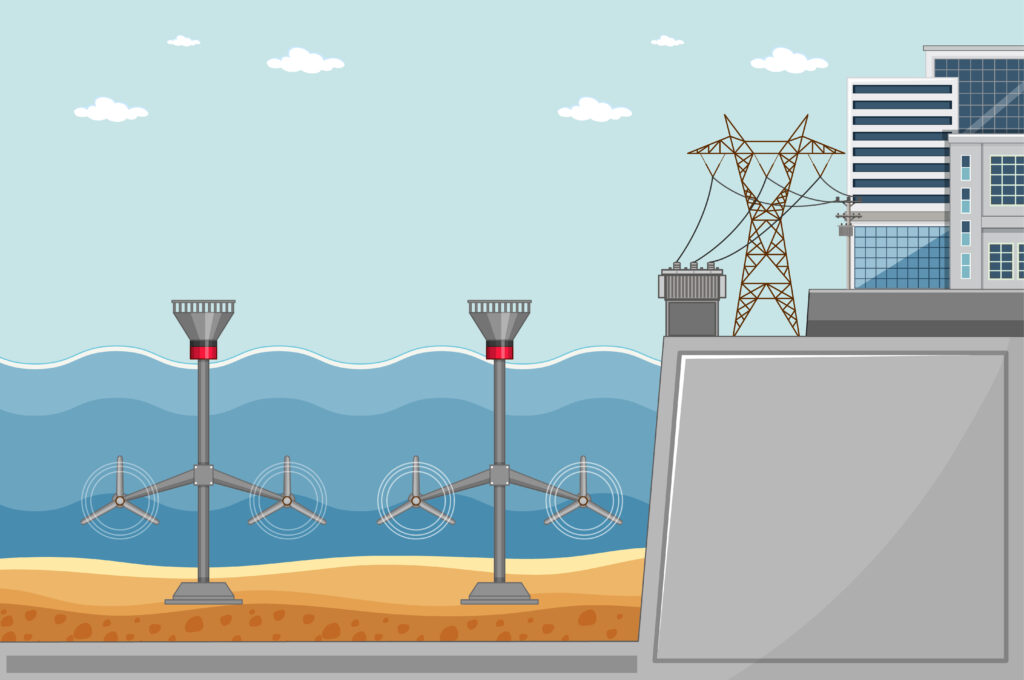
Table of Contents
Introduction: Embracing the Power of New Wave Energy
In the 21st century, the world is witnessing an unprecedented revolution in the energy sector – the rise of New Wave Energy. As concerns over climate change and finite fossil fuels intensify, a shift towards sustainable and renewable energy sources has become imperative. This article delves into the promising realm of New Wave Energy, exploring its potential, benefits, and the exciting future it holds for a greener and cleaner planet.
The Birth of New Wave Energy
New Wave Energy, also known as wave power or ocean energy, is a form of renewable energy harnessed from the natural movements of ocean waves. The concept dates back centuries, but significant advancements in technology and research have brought this once untapped energy source to the forefront of the renewable energy revolution.
In the early days, harnessing wave energy was merely an idea, but with the advent of modern engineering and innovative solutions, it has now become a reality. Wave energy conversion devices, such as oscillating water columns, point absorbers, and attenuators, have been developed to efficiently capture the energy contained within ocean waves and convert it into electricity.
How New Wave Energy Works

At its core, New Wave Energy harnesses the kinetic energy generated by the rise and fall of ocean waves. When waves move across the ocean’s surface, they carry vast amounts of energy, which can be converted into electricity. Several different technologies are used to capture this energy:
- Oscillating Water Columns: These devices are placed in coastal areas where the waves create air pressure variations within a chamber. The resulting air movement is then used to drive turbines and generate electricity.
- Point Absorbers: Point absorbers consist of buoyant structures that move with the motion of waves, generating mechanical energy. This mechanical energy is then converted into electrical energy through hydraulic systems.
- Attenuators: Attenuators are long, floating structures that move with the motion of waves. As they sway, they produce hydraulic pressure changes that can be utilized to generate electricity.
By employing these technologies, New Wave Energy offers a continuous and reliable source of clean electricity, without the harmful emissions associated with traditional fossil fuels.
Advantages of New Wave Energy
- Sustainability: One of the most significant advantages of New Wave Energy is its sustainability. Unlike traditional fossil fuels, ocean waves are perpetually in motion, making this energy source practically inexhaustible. As long as the Earth exists, waves will continue to roll onto our shores, providing a consistent and renewable source of power.
- Environmentally Friendly: Generating electricity from ocean waves produces minimal greenhouse gas emissions, reducing the overall carbon footprint. By reducing our reliance on fossil fuels, New Wave Energy helps combat climate change and its detrimental effects on the environment.
- Stable and Predictable: Unlike other renewable sources like solar and wind, ocean waves are more predictable, ensuring a stable and consistent energy supply without fluctuations. This predictability allows for better grid management and planning.
- Abundant Resource: With approximately 71% of the Earth’s surface covered by water, New Wave Energy has the potential to meet a substantial portion of the world’s energy needs. Utilizing even a fraction of this vast resource can significantly reduce our dependence on fossil fuels.
- Minimal Visual Impact: Offshore wave energy farms can be designed to have minimal visual impact on the coastline, preserving the natural beauty of coastal regions. This makes wave energy a more aesthetically pleasing option compared to some other renewable energy sources.
- Job Creation and Economic Growth: The development and implementation of New Wave Energy projects create new job opportunities and stimulate economic growth in the renewable energy sector. As this industry continues to grow, it will create a ripple effect of economic benefits for various communities.
Challenges and Solutions
While New Wave Energy holds great promise, it also faces some challenges that need to be addressed for its widespread adoption.
- Technology Development: Continued research and development are essential to optimize wave energy conversion technologies and increase overall efficiency. Investing in innovation and exploring new methods of energy capture will drive the industry forward.
- Environmental Impact: Proper environmental impact assessments are crucial to ensure that wave energy projects do not harm marine ecosystems. Collaborative efforts between environmentalists, scientists, and energy developers can lead to the implementation of responsible and eco-friendly projects.
- High Initial Costs: The initial investment required to set up wave energy infrastructure can be substantial. However, with advancements and scaling up, costs are expected to decrease over time, making wave energy more economically viable.
- Grid Connection: Wave energy farms must be connected to the power grid efficiently to distribute electricity to consumers. Collaborating with existing energy infrastructure and implementing smart grid technologies will help streamline energy transmission.
Leading the Global Wave Energy Revolution
Several countries are already at the forefront of the global wave energy revolution, actively investing in research, development, and implementation of wave energy projects. Among these trailblazers are:
1. Scotland

Scotland is considered a pioneer in the wave energy sector, with its rich coastline offering tremendous potential for harnessing wave energy. It is home to several leading wave energy companies and test centers that drive innovation and technological advancements.
2. Portugal

Portugal, with its long Atlantic coastline, has made significant strides in adopting wave energy technology. The country is committed to expanding its renewable energy portfolio, and wave energy plays a crucial role in achieving this goal.
3. Australia

Australia boasts vast coastlines with excellent wave energy potential. The country’s strong commitment to renewable energy, along with substantial government support, has positioned Australia as a key player in the global wave energy revolution.
4. United States

The United States is making significant efforts to explore and deploy wave energy projects. The Pacific Northwest, in particular, offers abundant wave energy resources and has become a hotbed for wave energy research and development.
The Future of New Wave Energy
As technology advances and economies of scale kick in, the future of New Wave Energy looks brighter than ever. With increased efficiency, affordability, and integration with existing energy systems, New Wave Energy is poised to play a significant role in shaping the sustainable energy landscape of tomorrow.
Continuous research and development will lead to more sophisticated and efficient wave energy conversion technologies, maximizing energy capture and reducing costs. Additionally, collaborations between governments, industries, and researchers will streamline regulations and incentivize the adoption of wave energy solutions.
As more nations embrace New Wave Energy, we can expect significant reductions in greenhouse gas emissions and a tangible contribution towards mitigating climate change. The global wave energy revolution will not only drive environmental benefits but also stimulate economic growth and foster innovation in the renewable energy sector.
Conclusion: Riding the Wave of a Green Future
New Wave Energy presents an incredible opportunity to revolutionize the way we generate electricity and combat climate change. With its inherent sustainability, minimal environmental impact, and abundant resource availability, it offers a promising solution to the world’s growing energy demands.
As governments, researchers, and private sectors join hands to unlock the full potential of this renewable energy source, we can ride the wave towards a greener and cleaner future for generations to come. Embracing New Wave Energy is not just
FAQ
What is New Wave Energy?
New Wave Energy refers to the harnessing of renewable energy from ocean waves. It involves converting the kinetic energy of waves into usable electricity to power various applications and contribute to a cleaner, sustainable future.
How does New Wave Energy work?
New Wave Energy systems typically use buoys, floating platforms, or other wave-capturing devices to capture the energy from ocean waves. As the waves move these structures, mechanical motion is generated, which is then converted into electrical energy through turbines or other means.
Is New Wave Energy environmentally friendly?
Yes, New Wave Energy is considered a green and eco-friendly energy source. It does not produce harmful greenhouse gas emissions or air pollutants, unlike fossil fuels. It is a renewable resource, relying on the continuous motion of waves, which makes it sustainable in the long run.
What are the benefits of New Wave Energy?
The benefits of New Wave Energy include its renewable nature, potential to reduce carbon emissions, and contribution to energy diversification. It can also stimulate economic growth, create job opportunities, and help mitigate the impacts of climate change.
Where is New Wave Energy being used currently?
New Wave Energy projects are being developed and tested in various coastal regions around the world. Countries with significant coastlines and strong wave resources, such as the United Kingdom, Portugal, Australia, and the United States, are actively exploring and implementing these technologies.
Are there any challenges to adopting New Wave Energy?
While New Wave Energy shows great promise, there are challenges to overcome, such as high initial costs, potential environmental impacts on marine ecosystems, and technological limitations. Nevertheless, these difficulties are being addressed by current research and development
How reliable is New Wave Energy as a power source?
The reliability of New Wave Energy depends on the location and the design of the wave energy system. Coastal areas with consistent and strong wave patterns tend to have more reliable energy generation. Advances in technology are also improving the efficiency and reliability of these systems.
Can New Wave Energy be combined with other renewable energy sources?While New Wave Energy is still in the early stages of commercialization, its economic viability is improving as technology advances and economies of scale are achieved. As the demand for clean energy rises, the cost competitiveness of New Wave Energy is likely to improve further.Can New Wave Energy be combined with other renewable energy sources?
Yes, New Wave Energy can be integrated into hybrid renewable energy systems. Combining it with other sources like wind, solar, or tidal power can create a more stable and consistent energy supply, enhancing the overall efficiency and effectiveness of the renewable energy grid.
Is New Wave Energy economically viable?
While New Wave Energy is still in the early stages of commercialization, its economic viability is improving as technology advances and economies of scale are achieved. As the demand for clean energy rises, the cost competitiveness of New Wave Energy is likely to improve further
How can individuals support the adoption of New Wave Energy?
Individuals can support the adoption of New Wave Energy by advocating for renewable energy policies, supporting research and development efforts, and choosing clean energy options offered by utilities that invest in wave energy projects. Additionally, raising awareness about the benefits of New Wave Energy can help drive its adoption on a broader scale

